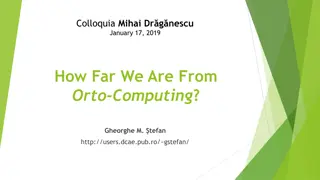
Key4hep Software and Computing Developments at CEPC Reviewed
Explore the collaborative software ecosystem Key4hep at CEPC, focusing on recent advancements, integration efforts, and strategic planning for future needs and international collaborations in the field of high-energy physics.
Download Presentation

Please find below an Image/Link to download the presentation.
The content on the website is provided AS IS for your information and personal use only. It may not be sold, licensed, or shared on other websites without obtaining consent from the author. If you encounter any issues during the download, it is possible that the publisher has removed the file from their server.
You are allowed to download the files provided on this website for personal or commercial use, subject to the condition that they are used lawfully. All files are the property of their respective owners.
The content on the website is provided AS IS for your information and personal use only. It may not be sold, licensed, or shared on other websites without obtaining consent from the author.
E N D
Presentation Transcript
SOFTWARE AND COMPUTING
Findings SOFTWARE AND COMPUTING Key4hep is a common software ecosystem that is collaboratively developed by all future collider communities, i.e. mainly CEPC, CLIC, FCC and ILC. It leverages established solutions developed for HEP, such as the Geant4 full simulation toolkit and ROOT, to provide essential components for detector geometry (DD4hep), event data model (EDM4hep) and application framework (Gaudi). CEPC has been an early adopter, actively contributing to the Key4hep stack since its inception at the Bologna Meeting in 2019. Noteworthy recent developments include the extraction of the Gaussino full simulation tool from LHCb for integration into Key4hep and the adoption of the ACTS tracking toolkit, which has led to an initial version of track fitting for the CEPC reference detector. They started very promising activities, addressing optimized compute performance and hence sustainability, like the use of generative machine learning for fast calorimeter simulation or TPC digitisation. As the reference detector incorporates novel detector technologies such as the crystal Ecal or the pixel-TPC, new reconstruction algorithms are also being developed. These include the CyberPFA algorithm and a particle identification (PID) algorithm utilizing cluster counting within the TPC. / Overall, the system is functional and built on well-established tools and components from a broader community. Its design is classical and robust, supporting detailed simulations and analyses for both detector performance studies and physics analyses. A simulation model for the reference detector has been successfully implemented in DD4hep. Computing resources for CEPC are based on tools and structures that are well-established within the LHC and the broader HEP community, employing a tiered computing architecture along with job submission and monitoring tools like Dirac and Grafana. Currently, 2,000 CPUs are available at IHEP, with an additional 2,600 CPUs at other sites, adequately meeting the current needs of CEPC studies. 2025/4/13 2 CEPC Detector Ref-TDR Review
Comments SOFTWARE AND COMPUTING Given the strong progress and recent advancements in the Key4hep ecosystem, we encourage the CEPC software team to integrate these developments back into the shared software stack. Collaboration with other Higgs factory concept groups on software tools, such as generative machine learning for fast simulation or ACTS integration, would be beneficial in reducing duplication of effort and maximizing resource efficiency. Agree, but not too much till now. main reason is manpower and time Currently, the long-term vision for software and computing evolution seems somewhat undefined. The present approach largely integrates existing components and aims to develop detector-specific solutions that will facilitate high-quality physics performance for the Ref-TDR. However, it would be valuable to articulate a more cohesive strategy that aligns with future CEPC needs. Needs further clarify the requirements. A key question remains on how a potential international collaboration is being considered within the software strategy. Furthermore, with CEPC likely to operate concurrently with major experiments such as the LHC, Belle-2, and EIC, it is essential to explore areas of mutual support, shared resources, and possibly unified frameworks for data analysis and computing. This strategic planning could enhance both technical and scientific synergies across these large-scale projects. Agree, further expand cooperation with major experiments, need more time 2025/4/13 3 CEPC Detector Ref-TDR Review
Recommendations SOFTWARE AND COMPUTING Given the rather ambitious timescale for the Ref-TDR, we recommend the following prioritized actions: 1. Ensure that the reference detector model used for full simulation incorporates realistic material budgets in the tracking region, including supports, services, and cooling infrastructure. Done / Asking for timely notice from hardware and mechanism 2. Focus on achieving a complete and well-tested full reconstruction for the reference detector in time for the Ref-TDR. This should demonstrate that key detector and software performance metrics, such as tracking and jet energy resolutions, are met. Where necessary, temporarily utilize existing software solutions (e.g., pad-based TPC reconstruction) if newer alternatives (such as pixel-based TPC reconstruction) are not ready in time. Almost Done / Tracking: effective pad-based PID: pixel based 3. Use full reconstruction to create basic detector performance plots, with realistic assumptions on detector resolutions, such as: In processing lead by Mingshui, no serious problem foreseen a. Track momentum resolution (for single muons) as function of pT for different values of cos( ) or Impact parameter resolutions in r and z b. c. Jet energy resolution as a function of cos( ), e.g., for uds di-jet events without ISR d. Flavour tagging performance Optimizing e. PID performance (using dN/dx and TOF) including separation power for K/ and K/p 4. Develop a realistic estimate of computing requirements for the reference detector, encompassing preparation, construction, and operational phases, ideally with an assessment of required human resources. Use data challenges to verify software and computing readiness. In processing / no matter for principle 5. Prepare a forward-looking computing and software strategy for the post-Ref-TDR phase, addressing: Long term strategy a. Data accessibility (open/shared) and long-term preservation b. Integration of emerging technologies and their anticipated applications over the next 5-10 years c. A systematic approach for documentation and knowledge capture d. Initiatives for training and attracting new programmers, particularly for long-term sustainability. 2025/4/13 4 CEPC Detector Ref-TDR Review






















